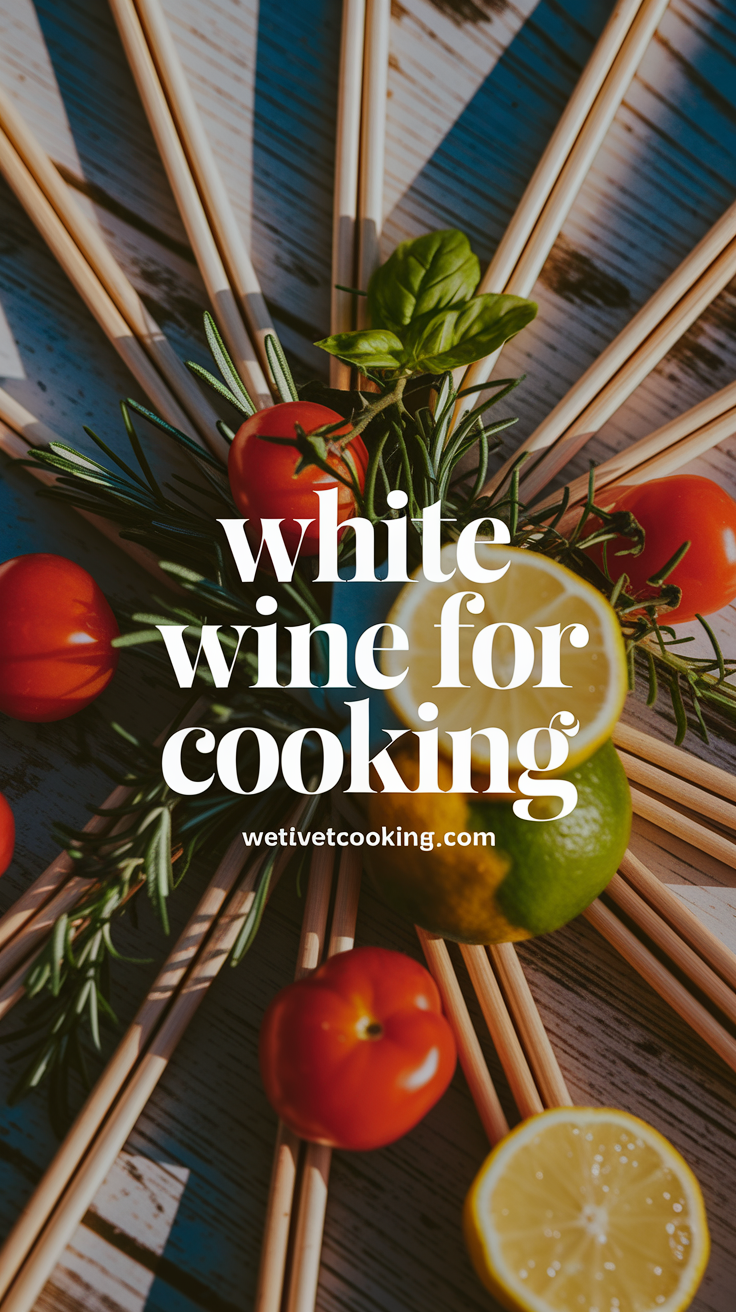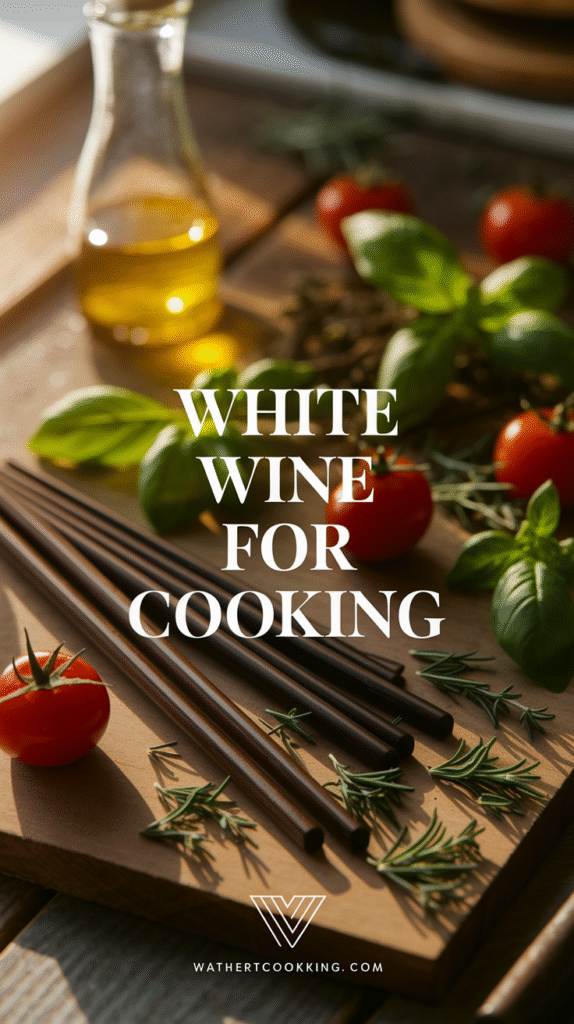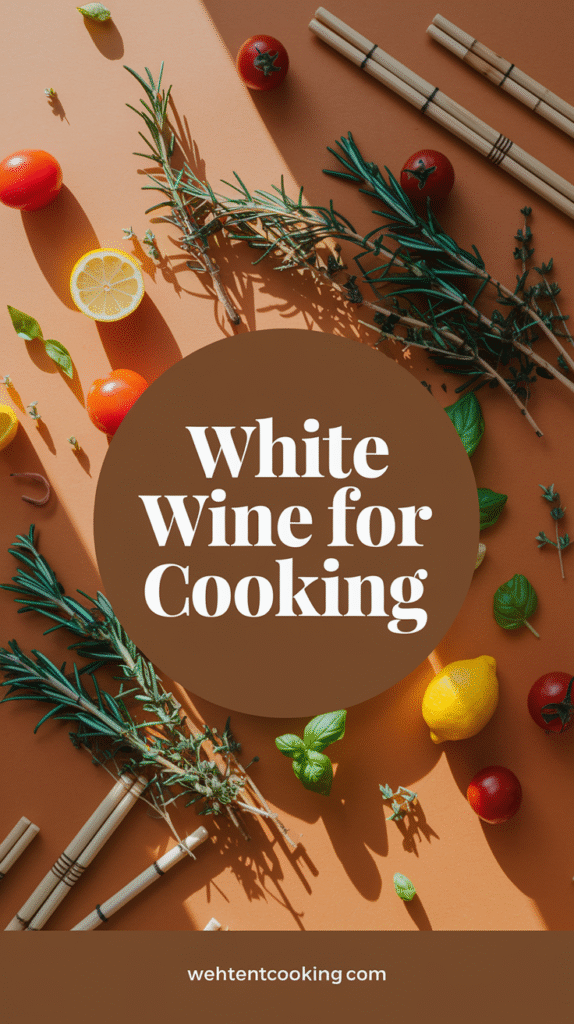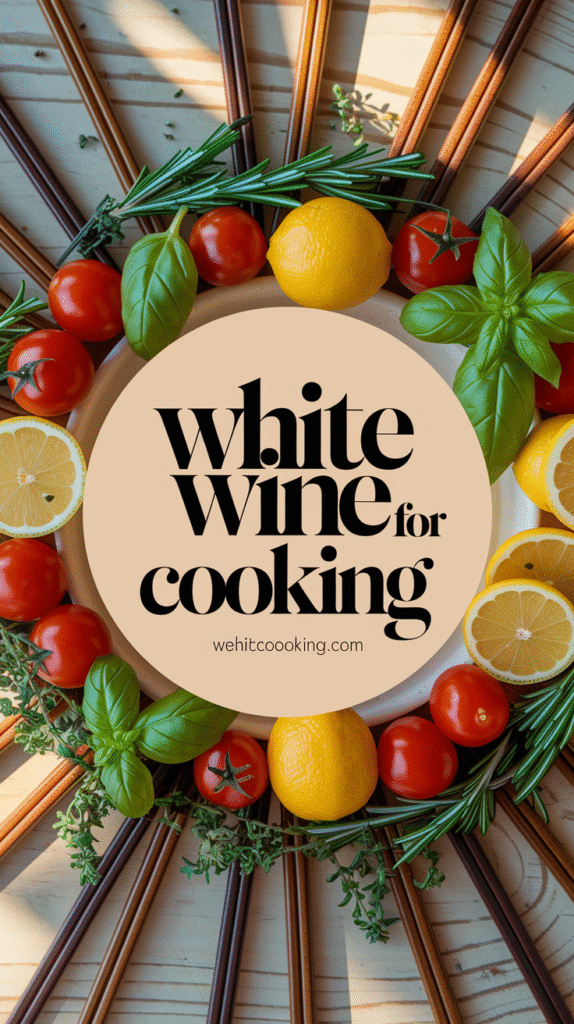White wine is more than just a delicious beverage; it’s a powerful ingredient in the kitchen that can elevate the taste of many dishes. When you cook with white wine, you harness its acidity, flavors, and aromas to create more complex and enjoyable meals. Let’s explore how white wine enhances flavors while cooking and why it deserves a spot in your culinary arsenal.
One of the main reasons to cook with white wine is its acidity. Acidic ingredients brighten flavors, balance richness, and add a refreshing note to dishes. Whether it’s a creamy risotto or a buttery sauce, a splash of white wine can help cut through the heaviness, making the dish more appetizing. The three main types of white wines used in cooking include:
- Sauvignon Blanc: Known for its crisp acidity and herbal notes, it works well with seafood and sauces.
- Chardonnay: This full-bodied wine adds richness to cream sauces and is perfect for poultry dishes.
- Pinot Grigio: With its light and zesty profile, it’s great for sautéed vegetables and light pasta dishes.
When adding white wine to your cooking, it’s crucial to consider the flavors in the dish. For instance, if you are making a light lemon chicken, a Sauvignon Blanc can complement the freshness of the lemon while enhancing the overall flavor. If you are preparing a creamy pasta, a Chardonnay can round out the dish beautifully.
Cooking with white wine also promotes the development of deeper flavors. As the alcohol evaporates, it leaves behind the essence of the wine, contributing notes of fruit and acidity that can intensify the overall taste of your food. It’s common to deglaze a pan with white wine. This technique involves adding wine to a pan after cooking meat, allowing you to scrape up the brown bits and create a flavorful sauce.
Here’s a simple step-by-step guide on how to incorporate white wine into your dishes:
- Choose the right wine: Opt for a wine that you would enjoy drinking. If you wouldn’t sip it, don’t cook with it!
- Use in moderation: A few splashes can enhance flavors, but too much wine can overwhelm the dish.
- Add at the right time: For most recipes, adding wine early in the cooking process allows the flavors to meld. Reserve some wine to drizzle over dishes before serving for an added punch.
Beyond savory dishes, white wine is also used in desserts. For instance, poaching fruits like pears or apples in white wine can enhance their natural sweetness and add depth. The wine infuses with spices like cinnamon or vanilla, creating a delightful finish to your meal.
It’s important to remember that not all wines are created equal. Cooking wines often contain added salt and other preservatives, making them unsuitable for quality cooking. Instead, choose a decent bottle and remember that vintage isn’t necessary—just avoid the cheapest options.
If you’re looking to expand your culinary repertoire, consider pairing different types of white wine with complementary foods. Here are some pairing suggestions:
| White Wine | Best Dishes |
|---|---|
| Sauvignon Blanc | Seafood, salads, goat cheese |
| Chardonnay | Chicken, lobster, creamy pasta |
| Riesling | Spicy dishes, pork, Asian cuisine |
For an in-depth exploration of cooking with white wine, check out Wine Enthusiast Magazine. They provide extensive guidelines and recipes that showcase the versatility of white wine in the kitchen. white wine can truly transform your cooking, leading to delicious meals that impress friends and family alike.
Cooking with white wine is about more than just adding a splash; it’s an art that can enhance your meals profoundly. From balancing flavors to creating rich sauces, white wine plays a vital role in culinary creativity. So next time you’re cooking, think about reaching for that bottle of white wine—it just might become your favorite cooking companion!
Best Types of White Wine for Culinary Use
When it comes to culinary applications, the choice of white wine can elevate your dishes and enhance flavors. Understanding the various types of white wine for cooking can help you make better decisions in the kitchen. Whether you’re creating a delicate sauce or marinating seafood, certain wines are best suited for your recipes.
One of the most popular choices for cooking is Sauvignon Blanc. This wine is crisp and has high acidity, making it great for enhancing the flavors of vegetables and herbs. It’s perfect in recipes for marinades, salads, and seafood dishes, providing a refreshing kick without overwhelming other ingredients.
Chardonnay is another excellent choice, particularly the unoaked variety. Its smooth, buttery flavor complements rich dishes like creamy sauces and risottos. Using Chardonnay can give your meal a luxurious feel, enhancing its overall taste profile. When you use this wine, aim for recipes that require a fuller body, such as chicken Alfredo or creamy seafood pasta.
A less common but equally effective option is Pinot Grigio. Its light and crisp characteristics make it a versatile addition to various dishes, especially poultry and light fish recipes. The subtle flavor of Pinot Grigio means it won’t overpower the main ingredients but will still add a decent amount of acidity and flavor.
Dry Vermouth is a fortified wine that can add an extra layer of complexity to your cooking. Whether you’re making a classic French sauce or a modern pasta dish, a splash of dry vermouth can elevate your sauce with herbal notes that enhance the overall dish. This wine is particularly great for deglazing pans and adding depth to risottos.
In contrast, Riesling can be used effectively in Asian cuisine or dishes that benefit from a touch of sweetness. The wine’s fruity notes make it an ideal match for sweet and sour dishes, improving the balance of flavors overall. Whether you’re preparing a stir-fry or a sweet glaze, Riesling can contribute a unique twist that tantalizes the taste buds.
When considering the best types of white wine for cooking, it’s essential to think about the other ingredients involved in your dish. Here’s a quick reference table:
| Type of White Wine | Best Use | Flavor Notes |
|---|---|---|
| Sauvignon Blanc | Seafood, Salads, Marinades | High acidity, Crisp |
| Chardonnay (Unoaked) | Creamy Dishes, Risottos | Buttery, Smooth |
| Pinot Grigio | Poultry, Light Fish | Crisp, Light |
| Dry Vermouth | Deglazing, Sauces | Herbal, Complex |
| Riesling | Asian Cuisine, Sweet Sauces | Fruity, Sweet |
Using the right type of white wine can bring your dishes to life. Always choose a wine that you would enjoy drinking, as the flavor of the wine can significantly influence your dish. Additionally, never hesitate to experiment; cooking is all about finding the perfect balance that works for your palate.
To enhance your culinary skills, consider checking other resources like Food & Wine, which offers amazing recipes and tips on cooking with white wine. Alternatively, The Kitchn provides insightful guidance on how to utilize white wine effectively in your kitchen adventures. These guides can significantly improve your comfort and creativity with using white wine in your cooking.
Cooking Techniques that Benefit from White Wine
Cooking with white wine can elevate your culinary creations, infusing dishes with rich flavors and complex aromas. Here are some cooking techniques that greatly benefit from the inclusion of white wine, enhancing both taste and texture.
Deglazing
Deglazing is a technique used to scrape up the browned bits left in the pan after searing meat or cooking vegetables. White wine is perfect for this because it adds acidity, which helps to lift the flavors from the pan. When you pour white wine into the hot pan, it helps dissolve those flavorful bits, creating a delicious base for sauces.
Braising
Utilizing white wine in braising can transform your dishes into hearty delights. When you slowly cook meat in liquid, the wine not only tenderizes but also infuses the dish with its unique traits. The acidity in white wine helps break down proteins, ensuring that the meat becomes tender while the flavors meld beautifully.
Marinades
Marinades are essential for imparting flavor. white wine into your marinade can introduce a subtle zing to meats, fish, or even vegetables. Here’s what you can use:
- Fish and Seafood: White wine complements the delicate flavors.
- Poultry: It adds depth to the seasoning profile of chicken or turkey.
- Vegetables: Enhances the natural sweetness of veggies when grilled or roasted.
Reducing Sauces
When making sauces, reducing white wine can concentrate its flavors, making it a great choice for flavor bases. After adding the wine to your sauce, allow it to simmer so that the alcohol evaporates, leaving behind a rich, complex flavor that enhances your dish.
Poaching
Poaching in white wine is a technique that keeps food moist and tender. Whether you are poaching poultry, seafood, or fruits, the wine adds layers of flavor. This method allows for a light, fragrant dish as the wine infuses natural aromas into whatever you are cooking. For instance, poaching pears in white wine serves as a delightful dessert option.
Sautéing
Sautéing with white wine can add depth to the flavors of your dishes. When you sauté vegetables or proteins, adding a splash of white wine not only enhances the taste but also adds moisture to prevent burning. It caramelizes additional sugars, bringing out the natural sweetness of your ingredients.
Baking
Surprisingly, white wine can also enhance baked goods! In recipes that call for fruit, using white wine can enrich flavors in cakes, tarts, and breads. The acidity helps to create a nice balance in sweet dishes, making flavors pop.
Flavor Pairing Guidelines
While working with white wine, pairing it correctly with your dish can make all the difference. Here are some popular pairings:
| Type of White Wine | Best Used For |
|---|---|
| Sauvignon Blanc | Fish, light chicken dishes, and vinaigrettes |
| Chardonnay | Poultry, creamy sauces, and roasted vegetables |
| Pinot Grigio | Seafood, salads, and light pasta dishes |
| Riesling | Spicy foods, Asian cuisine, and desserts |
Understanding the qualities of different white wines makes it easier for you to choose the right one for your cooking needs. When selecting, always opt for a wine that you would enjoy drinking, as the quality directly affects the flavor of your dish.
Integrating white wine into your cooking techniques can significantly enhance the flavors and aroma of your dishes. For more detailed information on cooking with wine, consider visiting Wine Enthusiast and Food & Wine Magazine.
Experimenting with these techniques can open up a world of culinary creativity. Enjoy the journey of cooking with white wine and the delightful dishes you create!
Pairing White Wine with Different Ingredients in Recipes
When it comes to cooking, using white wine can elevate your dishes in surprising ways. The right kind of white wine can enhance flavors, tenderize meats, and add depth to sauces. Understanding how to pair white wine with different ingredients in your recipes can transform your culinary experience. Below are some tips and combinations that can help you make the most of white wine in your cooking.
Choosing the Right White Wine
The first step in using white wine for cooking is selecting the right type. Different white wines have varying levels of acidity, sweetness, and flavor profile. Here’s a quick guide to common types of white wine and when to use them:
| Type of White Wine | Tasting Notes | Best Pairings |
|---|---|---|
| Sauvignon Blanc | Crisp, acidic, with notes of green apple and citrus | Seafood, chicken, salads |
| Chardonnay | Rich, full-bodied, with flavors of butter and oak | Pasta, creamy sauces, roasted vegetables |
| Pinot Grigio | Light and refreshing, with a hint of pear and almond | Light dishes, salads, shellfish |
| Riesling | Sweet and floral, with a bright acidity | Spicy dishes, pork, rich gravies |
Pairing White Wine with Different Ingredients
When cooking with white wine, you want to consider the dish’s main ingredients. Here are some suggestions for pairing white wine with various common ingredients:
Seafood
White wine complements the delicate flavors of seafood. A splash of Sauvignon Blanc can brighten grilled fish, while a rich Chardonnay pairs well with creamy seafood pasta. Consider using Riesling for spicy seafood dishes that require a touch of sweetness.
Poultry
Chicken dishes shine with the addition of white wine. For lighter recipes like lemon chicken, a zesty Pinot Grigio enhances the freshness. For richer sauces, a full-bodied Chardonnay works perfectly. Always remember to balance the flavors; the wine should enhance rather than overpower.
Vegetables
Cooking vegetables in white wine can add flavor and complexity. For sautéed greens or roasted vegetables, use a crisp Sauvignon Blanc for a refreshing contrast. When preparing creamy vegetable soups, a Chardonnay can add richness and depth.
Pasta Dishes
Pasta is a favorite canvas for white wine. For creamy sauces, opt for a Chardonnay to reinforce the richness of the dish. If you’re making a light sauce, consider using a Pinot Grigio for a refreshing touch. Quick tip: reserve some pasta water to mix with the wine for added starchiness and a silkier sauce.
Techniques for Cooking with White Wine
Integrating white wine into your cooking can be done in several ways:
- Deglazing: After sautéing meat or vegetables, pour white wine into the hot pan to dissolve the flavorful bits stuck to the bottom. This creates a fantastic base for sauces.
- Marinating: Use white wine as a key ingredient in marinades to tenderize meat and infuse it with flavor.
- Steaming: Add a splash of white wine to steam seafood or vegetables for added flavor.
As you experiment with different pairings and techniques, you’ll gain a better understanding of how white wine works with various ingredients. It’s not just about taste; the acidity in wine can help balance richness and enhance the overall dish.
For more detailed information on wine pairings and cooking techniques, check out Wine Enthusiast or Food & Wine. These resources offer extensive knowledge about different wines and recipes that can inspire your culinary journey.
Cooking with white wine can be both fun and rewarding. With the right pairing and techniques, you’ll create dishes that not only taste incredible but also impress your guests. So, pour yourself a glass, and let your culinary creativity flow!
Common Mistakes to Avoid When Cooking with White Wine
Cooking with white wine can enhance the flavors of your dishes, adding depth and richness that other ingredients simply can’t match. However, there are common mistakes that many home cooks make when incorporating this delightful ingredient. By avoiding these pitfalls, you can elevate your culinary creations and enjoy the full benefits of white wine in your cooking.
Choosing the Wrong Type of White Wine
One of the most frequent errors is selecting an unsuitable type of white wine for cooking. Not all wines are created equal, and using a low-quality or overly sweet wine can lead to disappointing results. Here are a few tips to help you choose wisely:
- Select Dry Varieties: Opt for dry white wines like Sauvignon Blanc, Chardonnay, or Pinot Grigio. They pair well with a range of dishes, from seafood to chicken.
- Avoid Cooking Wines: Avoid bottled cooking wines, which often contain added salt and preservatives. Instead, use a wine you would drink.
- Consider Flavor Profiles: Think about how the wine will complement your dish. A fruity wine can enhance light, fresh recipes, while a more robust wine can stand up to richer dishes.
Using Too Much or Too Little Wine
Another common mistake is miscalculating the amount of wine to use. Too little wine can leave your dish lacking in flavor, while too much can overwhelm the other ingredients. Follow these guidelines:
- Start with a Little: Begin by adding a small amount of wine, typically a few tablespoons. You can always add more if needed.
- Balance Flavors: Pay attention to the overall flavor balance of your dish. If you add too much wine, consider adding more of the main ingredient to counteract it.
Not Cooking Off the Alcohol
Many people mistakenly think that the alcohol content in white wine simply cooks off without any special attention. While some of it will evaporate during cooking, the longer you cook the wine, the more flavor it will impart to your dish. Here’s what you should know:
- Simmer, Don’t Boil: Simmer the dish to allow flavors to meld while giving alcohol time to evaporate. Boiling can concentrate the alcohol and create harsh flavors.
- Cook Long Enough: Depending on the recipe, ensure that you cook for at least 10-15 minutes for the alcohol to significantly reduce, double-check with a taste test.
Neglecting to Pair with Food
White wine can enhance your meal, but neglecting to pair it thoughtfully can lead to awkward flavor combinations. Here are tips for pairing:
- Fish and Vegetables: These are best accompanied by crisp whites like Pinot Grigio or Sauvignon Blanc.
- Poultry and Creamy Sauces: Chardonnay works beautifully with these types of dishes, providing a buttery richness.
Failing to Consider the Cooking Method
The cooking method can significantly affect how white wine interacts with your dish. Here’s what to keep in mind:
- Sautéing: When sautéing, deglaze the pan with white wine after cooking your protein. This captures the flavors left in the pan.
- Slow Cooking: When using in slow-cooked meals, consider adding the wine at the beginning to allow its flavors to permeate.
Ignoring Freshness and Storage
Using stale or oxidized white wine can dramatically impact the flavor of your dish. Keep these tips in mind to maintain wine quality:
- Store Properly: Keep opened white wine sealed and refrigerated. Consume it within a few days to ensure freshness.
- Cork It: Use a vacuum pump to seal your wine bottles for maximum shelf life.
By avoiding these common mistakes when cooking with white wine, you can significantly improve your dishes and surprise your guests with delightful flavors. Make sure to source quality white wines, consider your cooking methods carefully, and always taste as you go!
For more information on cooking with white wine, visit Food & Wine and The Spruce Eats.
Conclusion
To truly elevate your cooking, incorporating white wine can make a significant difference. By understanding its role in enhancing flavors, you can transform dull dishes into culinary masterpieces. From crisp Sauvignon Blanc to buttery Chardonnay, the best types of white wine for cooking each add their unique essence to your meals. Exploring various cooking techniques such as deglazing, roasting, and simmering allows you to harness the power of white wine in diverse ways, bringing out the natural flavors of your ingredients.
When it comes to pairing, choosing the right white wine with different ingredients can unlock delightful flavor combinations. For instance, a dry white wine works well with seafood, while a sweeter option may complement chicken dishes beautifully. However, as with anything, it’s essential to avoid common mistakes that can lead to less-than-ideal results. Overcooking the wine, using inferior quality, or mispairing with ingredients can dampen the impact of this versatile cooking companion.
So, whether you’re seasoning a sautéed dish or adding a dash to a sauce, remember that a thoughtful approach to using white wine will enrich your culinary creations. Embrace the possibilities and enjoy the journey of discovering how white wine can elevate your cooking, making every meal an opportunity for exciting flavor exploration. With these insights in mind, you can confidently experiment and create dishes that delight the palate and impress your guests.







Leave a Reply